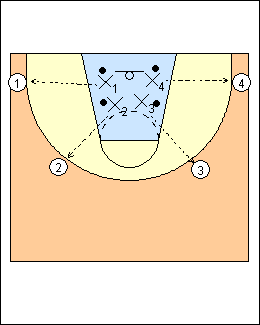Hubie Brown spot
 | 1 Hubie Brown Four shooters are paired with a rebounder/passer (chest and flick passes). Shoot five shots from each of the four spots. As a pass is coming to the shooting shoulder, step (1-2), catch in a T (elbow in, shooting hand behind the ball, guide hand beside it), go up, release and reach (follow through, for backspin). Shooters should think step, catch in a T, release. Chest passes are to the shooting shoulder, flick (two-hand) passes are eye to eye. Tony Barone - a zone shooting drill, every day in practice, shoot five then change shooters. There's no hurry, make a good pass, catch and step into shot. Hal Wissell - shooting rhythm comes from a down-and-up motion of the legs. When shooting off the catch, the "down" comes just before the catch, and the shot goes up as the legs go up (a one-count shot). Keep the ball high, don't lower it. On long-range jump shots, you can generate more force by stepping into the shot (although it becomes a two-count shot). A good shot fake gets the defender to straighten his legs, creating space to shoot over him. coachesclipboard.ca - on a perimeter shot, the shooter should start by looking over the ball, and release the ball on way up, before reaching the apex of the jump. Billy Donovan - show hands, use a 1-2 step, if you are square to the basket it gets your momentum going to the basket, making it a shorter shot. Bill Self - backstop the ball on the catch and step into the shot, catch with a 1-2, right-handers catch left foot touching as the ball enters their hands and step with their right foot. Scott Adubato - the shooter gets low, square to the basket, shows a target hand, catches with a 1-2 step into the pass (left-right for a right-hander, left pivot foot), right elbow in, eyes on the rim, raises, extends and follows through. For a quick, snap release, have the feet set, be low, don't bring the ball down. Kevin Eastman - be ready on the catch, play low to high. Mike MacKay - stepping into a shot you move your hips forward to generate forward momentum, so the hips have risen on catching the ball, it is very difficult to generate power from the legs, and now you have to step again, dip down, or find power from the upper body. You should instead pivot the hips into the shot, the lead leg stays still, the back hip pivots to meet the lead hip, allowing the legs to stay low and loaded. If you are moving forward to catch the ball a step is appropriate, the key is when the first foot hits not to take a second step with the trail leg, ideally the second foot touches the ground as the ball is being caught. Hopping into the shot eliminates this problem, but can require more strength and timing to control the hop. Mike MacKay - at the 2009 World Junior Championships, the majority of top shooters hopped into their 3-point shot as opposed to the inside-pivot step. They often start with the feet in a stagger position, as the pass is in the air they hop on both feet to catch the ball. This allowed them to drive upward into a jump shot as opposed to a pushing action which often comes from stepping into the shot. Another benefit was that they could use either foot as a pivot foot if they decided to drive. Also, they were much more able to react to a bad pass and maintain rhythm into the shot. The players who anchor one foot into the ground sometimes refuse to give up their position to maintain possession, this often leads to one-handed catches and a loss of rhythm. Frankston Blues - the shot path is the path the ball follows from set point to follow through. The ball should travel up the shot path then forward to the basket (up and out motion), the shooting forearm and bicep work as an elevator, not levers. Bringing the ball down before bringing it back up is negative motion that slows down the shot and causes you to lose any upward momentum you have created by shooting in one motion. Bringing the ball backward towards (and sometimes behind) the head also creates negative motion and often a sling-shot type action. Jay Wright - when you practice technique and footwork, have your guys think about what they are doing; when you practice game speed, don't think. See Hubie Brown shooting off the dribble and on the move. |
This page was made with Basketball playbook from Jes-Soft